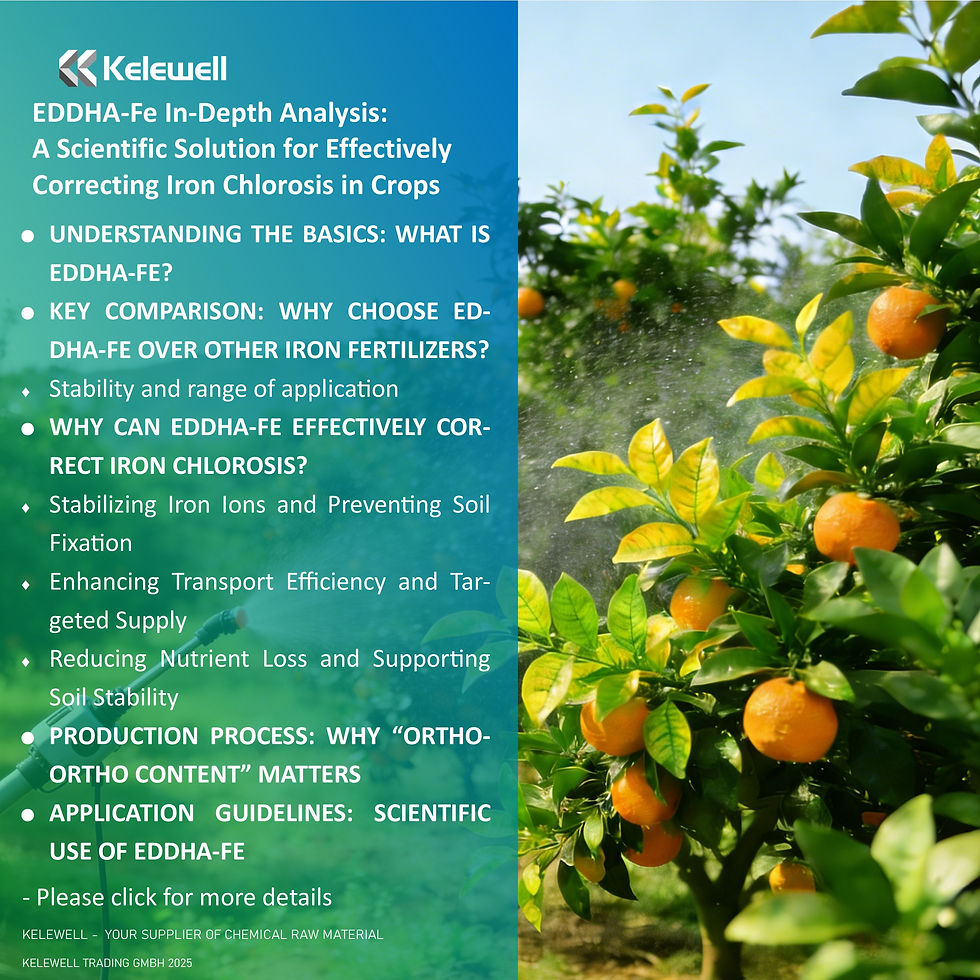Boric Acid and Borax: From Legal Uses to Food Safety Red Lines
- Camille W.

- Jun 25
- 4 min read
I. Diverse Applications of Boron Compounds: A “Double-Edged Sword” in Industry and Agriculture
1. Industrial Applications: A Versatile Performer
Borax (sodium tetraborate) is a key boron-containing mineral with industrial uses across numerous sectors:
Personal Care & Pharmaceuticals: Acts as a buffering agent to regulate pH in detergents, or as a preservative in cosmetics (e.g., baby powder, toothpaste). Historically used as an external antiseptic, but now restricted due to toxicity risks.
Glass & Ceramics: Reduces melting point and improves transparency in optical glass; critical for making eyeglass lenses and heat-resistant borosilicate glass. Enhances glaze gloss and hardness in ceramics.
Metallurgy & Welding: Dissolves metal oxides at high temperatures, improving weld quality by cleaning copper, iron, and other surfaces.
Other Uses: Serves as an insecticide by damaging insect digestive systems; in fire safety, used in flame retardants to suppress combustion.
[Boric Acid in Glass Industry]:
2. Agricultural Use: A Micronutrient Guardian
As an essential micronutrient, boron plays irreplaceable roles in plant growth:
Reproductive Development: Vital for crops like rapeseed, cotton, and fruit trees. Boron deficiency can cause flower abortion due to inhibited pollen tube growth.
Cell Wall & Sugar Metabolism: Supports pectin synthesis for cell wall flexibility (e.g., celery stalk rigidity) and aids sugar transport from leaves to fruits, enhancing sweetness in grapes and tomatoes.
Stress Resistance: Prevents fungal diseases (e.g., heart rot in beets) and improves drought tolerance by enhancing water uptake in roots.
[Boric Acid in Agriculture]:
II. A Toxic Additive in Food: Illegal Practices and Public Health Hazards
1. The “False Benefits” Behind Illegal Use
Unscrupulous vendors add borax or boric acid to food due to three cost-effective but dangerous “advantages”:
Noodle Texture Modification: In cold noodles and wheat products, boron cross-links with gluten, enhancing elasticity and giving a bright white, glossy appearance.
Preservation of Meat Products: In meatballs or tripe, it binds metal ions to delay oxidation. Applied on duck meat, it restores red color by reacting with hemoglobin.
Seafood and Dry Goods Processing: Retains moisture in squid and shrimp, increasing weight; mushrooms and silver ear fungus soaked in boric acid appear fuller and shinier.
2. Toxicity Mechanisms: A Silent Threat
Metabolic Trap: Ingested borax converts to boric acid in the stomach. Slowly excreted by kidneys (half-life ~50 hours), it can accumulate in bones, thyroid, and other tissues.
Toxicological Data:
Reproductive Toxicity: Long-term exposure reduces sperm count and activity in males, impairs ovarian function in females, and may increase birth defect risk (e.g., neural tube defects).
Endocrine Disruption: Boric acid mimics estrogen, interferes with thyroid hormones, and may impair brain development in children.
Acute Toxicity Thresholds: In adults, 1–3g may cause nausea/vomiting; 15–20g may be fatal. Children are more sensitive—5g can be life-threatening; 2–3g may be fatal to infants.
3. Legal Boundaries
Most countries strictly ban borax and boric acid as food additives, listing them as “non-edible substances illegally added to food.” Offenders may face criminal penalties for “producing or selling toxic or harmful food,” with maximum punishment including the death penalty.
III. Consumer Protection: From Recognition to Action
1. Visual Warning Signs
Color: Meat should be naturally pink or red; meat treated with borax often appears unnaturally bright or dark red. Overly white noodles or skins lacking natural bran hue should raise suspicion.
Texture: Fresh meat is slightly sticky. If slick or waxy (or with powdery residue), borax may be present. Overly elastic noodles or dumpling skins may also indicate boron.
Smell: Excess borax can give off a faint alkaline or soapy odor, masking spoilage-related sour smells.
2. Scientific Testing and Consumer Action
Basic Testing: Use pH test strips on soaking water; if pH > 8, further testing is advised. Rapid tests (e.g., boric acid test paper) are available through market regulators.
Choose Safe Sources: Buy only from licensed food producers with traceable supply chains. Avoid street vendors and unlicensed outlets.
Reporting Channels: Report suspicious products via consumer hotlines. Authorities may use lab methods like ICP-MS to measure boron content.
IV. Deep Reflection: From Isolated Cases to Systemic Governance
The illegal addition of boron compounds exposes complex challenges in food safety:
Cost Gap: Borax/boric acid are cheap, but detection is expensive, tempting small workshops to take the risk.
Consumer Blind Spots: Public perception of “extra freshness” may unwittingly reward adulteration.
Solutions require action from all sides:
Regulators: Implement source control (e.g., real-name registration for borax sales).
Producers: Adopt industry-wide blacklists for boron compound misuse.
Consumers: Promote education (e.g., through community talks or short videos) to improve detection skills.
Only by drawing a clear line between the industrial utility and food toxicity of boron compounds can we safeguard the food supply from farm to table.
V. Proper Use of Borax and Boric Acid
Borax and boric acid are not inherently dangerous. When applied correctly in industrial production and agriculture, they serve as essential inputs driving progress. However, misuse—especially in food—can pose serious health risks.
All stakeholders—producers, researchers, and consumers—must embrace a science-based understanding to maximize the positive applications of boron and avoid turning it into a hidden threat.
Note: Industrial data sourced from the Handbook of Boron Compound Applications. Toxicity data referenced from the WHO Environmental Health Criteria for Boron.




Comments